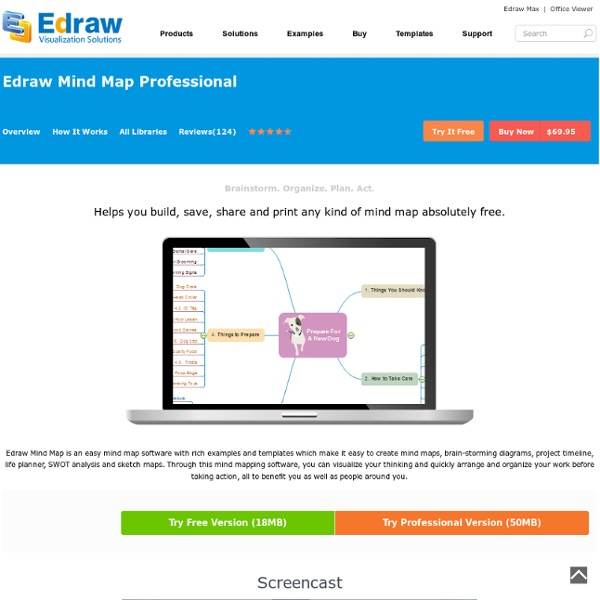Edraw Mind Map Professional
Clarify Thinking Edraw can easily conceptualize your visualization on computer and organize your work. It helps you pull all ideas and assets together to organize them in logical structure, then to steer clear of irrelevant information and recognize the critical. Finally, you can better evaluate the profit, cost and risk for better decisions. Arouse Interests People often lose interest when facing piles of materials with only text which are boring and rigid. Boost Individual Brainstorming It is recommended to "look before you leap". Unlock Creativity In this highly competitive society, creativity is highly valued. Increase Productivity When the clock is ticking, high productivity is vital to ensure success.
Coggle | Top Picks
Loading ... Coggle is a browser-based organic-style mind-mapping application. It supports simultaneous, multi-user editing with chat. It allows free placement of nodes and can also make a new map from an existing FreeMind (.mm) file. Nodes can also have web links and images attached. Price: Free Special attribute: Supports LaTeX for mathematical notation. More screenshots and details for Coggle on Mind-mapping.org Top Picks are tools that are in the mainstream of mapping or are significant because they have special attributes that you won’t easily find in other tools. Google
Free mind mapping (and related types) software
I see regular inquiries on Twitter and in forums from people looking for free software to support visual thinking. To provide answers, InformationTamers have put together 14 pages to help you find the one for your needs. These show the platform, a screen thumbnail and a link for more information in each case. We built this article using the most complete source for details of information mapping software on the Web: Mind-mapping.org. Mind-mapping.org has a good capability for selecting software by map type and operating system (click on the ‘Refine software list’ tab at the top right of its web page). “Free” here is as in beer, not in freedom, though some of the software listed is open source, so is free in both senses. Of course a pencil and paper is always almost free. This used to be one long page, but as I updated and added to it, it became unmanageable, so now it’s broken down by category. Click through for more details:
Tinderbox
Save 25% on Tinderbox and Storyspace during the 2019 Festival of Artisanal Software. Tinderbox is just $199 — save $50! Storyspace is just $114 — save $35! A new era for Tinderbox: the tool for notes. Hyperbolic Views let you explore complex link networks Filtered Outlines help you focus your attention Maps are faster, more elegant, and more responsive Brainstorm even more quickly: just drag a link to an empty space to create a new linked note Tinderbox is now scriptable and cooperates even more smoothly with even more tools. Whether you’re plotting your next thriller or writing your dissertation, designing a course, managing a legal practice, coordinating a campaign or planning a season of orchestral concerts, Tinderbox 8 will be your personal information assistant. Now available: Tinderbox 8.2.2 WinterFest! The Winter Festival of Artisanal Software brings great prices on some of the best software — including Tinderbox and Storyspace, direct from the makers. (Click to close) J. Prof.
Curio - Mind Mapping, Brainstorming, and Project Management Software for Mac OS X
The Real World You have work projects and home projects, school classes to manage and book reports to research, vacations to plan and novels to write, web sites to design and lab results to organize. You currently use a collection of notebooks, your office whiteboard, scraps of sticky notes, oodles of browser bookmarks, and multiple documents scattered around your hard disk. You’re juggling it all, but organizing this information should be easier. A Better World! In Curio, create a project to represent your real-world project, then fill it with everything related to that project including notes, images, documents, web links, and much, much more. Anything placed into Curio can be associated with tags, flags, checkboxes, priorities, ratings, and start/due dates and durations, for fast and easy searching and task management. The best part is you are in complete control over your idea spaces. Thousands of customers around the world use Curio in a surprisingly diverse range of occupations.
Related:
Related:



